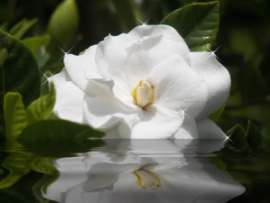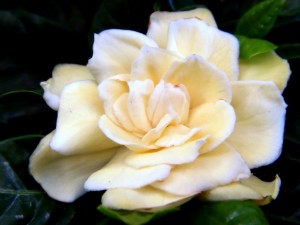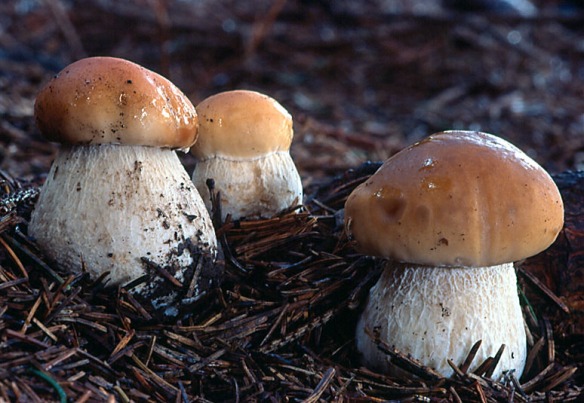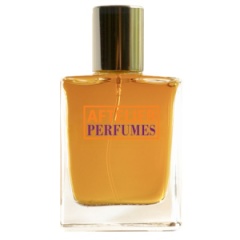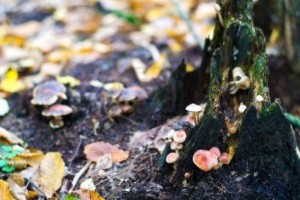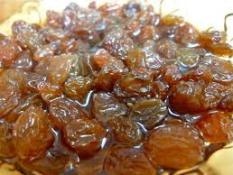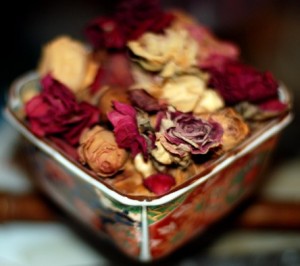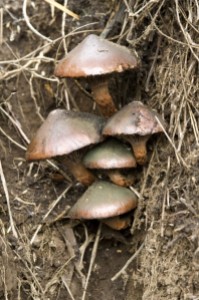Some perfumes immediately transport me to a place in time. For Palimpsest, it is a summer’s walk in an orchard on the brightest of days. Sun-ripened fruits drizzled with honey hang heavy and low on trees, irresistible in their sweetness. There are lush peaches for as far as the eye can see, but a small portion of the orchard is devoted to yuzu grapefruits, while bright, banana-yellow ylang-ylang flowers grow further in the distance. One peach beckons to you, and you take a bite, its juices running down your chin, as a smear of animalic honey coats your lips. There is a subtle suggestion of golden flowers swirling in the warm air around you, along with tendrils of smoky woods, vanilla, and amber, but the overall feeling is that you’re walking in sunshine. That is the essence of Palimpsest, a fragrance released last week by the acclaimed doyenne of natural perfumery, Mandy Aftel of Aftelier Perfumes.
Continue reading
Tag Archives: Mandy Aftel
Aftelier Perfumes Cuir de Gardenia
The beauty of a gardenia, with all its multi-faceted richness and inherent contradictions, captured in a perfume that is sometimes much more about a mood than a particular set of notes. That is Cuir de Gardenia, a feat of technical skill, innovation, and perfume mastery by the acclaimed doyenne of all-natural perfumery, Mandy Aftel of Aftelier Perfumes.
On her website, Ms. Aftel has a wonderfully detailed explanation of why Cuir de Gardenia is different from many “gardenia” scents, along with discussion of its character and structure:
Cuir de Gardenia retains the unique beauty of the tiare [Tahitian gardenia] flower, not allowing it to morph into the hundreds of petals of a floral bouquet. I had been incredibly fortunate to find an artisanal grower and distiller of the ultra-rare, costly, precious gardenia. In Cuir de Gardenia, I wanted to retain the pure loveliness of the creamy sweet and singular gardenia fragrance, and knew that the rounded warmth of an oil-based perfume (solid and extrait) would be the perfect format.
Cuir de Gardenia is unusual in that it has no top notes; I created it in such a way that the gardenia appears immediately, unimpeded from the opening of the perfume onward, merging seamlessly with the leather. The natural isolates ethyl phenyl acetate (reminiscent of a bunch of sweet peas) and the candy-like maltol contribute sweet and floral notes to the animalic base of the perfume.
Cuir de Gardenia comes in two concentrations: an extrait de parfum oil and a solid perfume. This review is for the former, the extrait de parfum. The perfume is classified on Fragrantica as a “floral woody musk,” while Ms. Aftel categorizes it as “dry woods.” According to Ms. Aftel, the notes are:
Middle: tiare (gardenia) absolute, jasmine grandiflorum absolute, benzyl acetate.
Base: castoreum, ethyl phenyl acetate, maltol.
It was interesting to smell Cuir de Gardenia merely in the vial. You are struck by an intense burst of heady, rich gardenia with hints of jasmine and a strongly animalic whiff.
The latter evoked two very different images in my mind. First, the smooth flanks of an animal covered in leather that has been burnished in lush perfumed oils. Second, the flanks of the human body, with the curve over the hips and slightly musky, satiny smoothness. There is something to both visuals, as Cuir de Gardenia is more than a mere floral scent. Still, there is no doubt that the main note is unquestionably gardenia. In the vial, it smells like a full-throttled gardenia or, more accurately, the essence of thousands of flowers distilled into a few, concentrated, precious drops. As a whole, Cuir de Gardenia is almost more of a mood and feeling than a mere scent.
It’s a different matter on the skin, at least at first. Cuir de Gardenia is an oil, and the first thing I was struck by when I applied it was the glistening, golden sheen it leaves on the skin. For me, smell of the oil initially acted as a barrier between the headiness of the flower that was so apparent from sniffing the vial. You have to give it a few minutes for the oiliness to dissipate and melt. Once the heat of your skin breaks it down, Cuir de Gardenia starts to show itself in all its multi-faceted richness.
Cuir de Gardenia opens on my skin with a fierce blast of strong castoreum musk, infused with the fresh gardenia flower, greenness, and a tinge of sourness. Depending on how much of the perfume you apply, the castoreum either leads the charge or comes in second place. When I applied a lot (about 3 big dabs of the oil), the muskiness was both intense and very animalic, verging almost on the feral. (You can read more about castoreum on Fragrantica, if you’re interested.) It made me think of how Ms. Aftel was reported to buy a very ancient, vintage stock of the beaver secretion from the estate of a former perfumer and how that ingredient is said to be such a part of her Secret Garden fragrance. I suspect the same stock was used for Cuir de Gardenia.
When I applied a smaller amount of the oil, the dominant impression for me was something else. I was struck by how Cuir de Gardenia felt more like a texture. Yes, there is the gardenia that is more moderately indolic and encased in a subtle warmth tinged with the castoreum’s musky, plush, velvety undertones. However, my main impression was rich, Devon clotted cream and butter. Cuir de Gardenia opens like floral butter, touched by a hint of sourness and green. The latter is an unexpected freshness that feels quite contradictory given how rich and ripe the flower can be.
I’m struck by the polarity and juxtapositions. Velvety petals that feel like buttered cream, next to dewy moisture and greenness. You have the gardenia on the stem in the early morning hours, but also the headiness of that same flower after it’s been plucked and its aroma has concentrated over time. None of it feels blowsy or decayed; there are initially no mushroomy undertones nor earthiness the way gardenia can sometimes manifest. Depending on quantity, it is either quietly lusty in its muskiness, or a little bit feral.
Ten minutes in, Cuir de Gardenia smells like buttermilk with its green, sour cream undertones. Deep in the base, there is a subtle whiff of something rubbery, but it’s more textural than anything black or leathered. It’s as if there were so much gardenia richness that it has coagulated and solidified into a hardened oil. I know I’m not doing a good job of explaining all of this, but that is because I’ve never quite encountered a gardenia like this one. For a perfume centered around one main note, there are a lot of unexpected, almost contradictory, complex facets in the opening hour.
I think that’s a testament to Ms. Aftel’s deft handling of the flower. It would have been all to easy for Cuir de Gardenia to be a simple, indolic, voluptuous gardenia. With all that richness, you’d almost expect a single-minded, typical gardenia. Instead, Cuir de Gardenia is one of those rare scents that somehow captures all the tiny, often disparate, layers to the flower actually growing in nature. What it isn’t is raunchy or dirty. This is a very different sort of “indolic” theme than what one usually encounters, one that is more musky than voluptuously narcotic on my skin.
And, in truth, Cuir de Gardenia’s headiness is a very quiet one. I’m not surrounded by an avalanche of gardenia; there is no nuclear-tipped cloud wafting around me, emanating a lavishly thick, voluptuous fleshiness. Cuir de Gardenia is much more restrained. I have to admit, I personally prefer my white flowers on the Wagnerian side, but there is no denying Cuir de Gardenia’s refinement. It is more akin to Vivaldi’s Four Seasons than to the Ride of the Valkyries, more Mozart’s Eine Kleine Nachtmusik Allegro than Beethoven’s Ninth or his Ode to Joy. None of that is meant as an insult. I love all those pieces, deeply, and I listen to Mozart more than I do to Wagner’s powerful “Apocalypse Now“- style piece, but there is no denying that there are distinct differences in style, tone, and mood.
At the end of 30 minutes, the perfume hovers an inch above the skin in a mix that is at once delicate, restrained, and rich. When you apply a larger quantity of Cuir de Gardenia, it adds another hour to the time frame before the sillage drops. In both cases, when smelled up close, the perfume is a massively concentrated hit of lush, buttery smooth gardenia infused with greenness and a tinge of buttermilk sourness. The gardenia is carefully placed upon a soft castoreum base that is very quietly musky, plush, velvety, and dark. Yet, there is very little of the animalic whiff that I detected when I smelled Cuir de Gardenia in the vial or that the perfume opened with when I applied a lot. The castoreum seems to have melted into the petals, having an indirect effect on the notes in a much more discreet manner. The whole thing is lovely, and I’m very impressed by the carefully calibrated balance.

“Dressage Black and White” by Diana Rose Greenhut or DianaExperiment on Flickr. (Website link embedded within.)
You may have noticed that I’ve barely mentioned leather at this point. Well, initially, it didn’t show up on my skin in any discernible fashion. Then, suddenly, right at the 30 minute mark, things start to change. There is a muted impression of an ultra-expensive, high-end Hermès saddle which carries the tiniest lingering traces of the horse it had been on many hours before. There is something almost akin to civet in the animalic muskiness that is starting to stir on my skin. Lurking in the distance and at the edges are tiny flickers of notes that are simultaneously mushroom-y, earthy, vaguely chocolate-y, and nutty. It is undoubtedly due to the gardenia’s mushroom side combined with the castoreum. Whatever the cause, it adds dimension to what was previously and primarily a fresh-ripe, green-creamy floral bouquet.
The issue of the leather is perhaps the best evidence for how beautifully Cuir de Gardenia has been blended and the technical mastery involved. For the first hour, the leather never stays in one place on my skin, but moves throughout the notes like a very friendly ghost. Sometimes, he stops to say hello, and remains to chat for 4 or 5 minutes. Then, he drifts away to other worlds for a brief span, before popping back in. Every time I think he’s finally vanished, he waves a dark, friendly, leathered arm at you from the horizon. Then, suddenly, 90 minutes in, he decides to move in permanently. And he’s brought luggage with him! Suitcases filled with black smoke whose tiny tendrils wind their way up from their depths to slowly wrap their threads around the creamy gardenia. The leather ghost gives you a cheeky grin, puts his feet up, and is there to stay.
Yet, I want to emphasize that this is a very subtle, muted “leather” as a whole. It’s not the sort of leather that you have in fragrances like Etat Libre‘s hardcore, black Rien, the deeper, burnished brown leather of Puredistance M, the distinct leather of Parfums Retro‘s Grand Cuir, or the animalic leather of LM Parfums‘ Hard Leather. The note here is more about an impression of leather. It is strongly infused with an animalic edge that sometimes feels a bit civet-like in nature, and it creates a subtle kinship to horsey leather. To be clear, though, the note is never fecal but is primarily just musky. Still, if you’re expecting a true, hardcore leather fragrance, you need to put those thoughts aside. Cuir de Gardenia is a spotlight on gardenia first and foremost. The flower merely happens to have a animalic leather undertone that distinguishes it from the traditional take on the note.

“Gardenia sketch” by Angel H. Juarbe on Fine Art America. http://fineartamerica.com/featured/gardenia-sketch-angel-h-juarbe.html
From the start of the third hour until its end, Cuir de Gardenia is a seamless blend of gardenia with animalic “leather” and musky touches. The smokiness lingers, but it becomes increasingly overshadowed by the warmth in the base that makes the gardenia more golden in feel. It is a skin scent on me at the 2.5 hour mark, but Cuir de Gardenia’s longevity is excellent. As an extrait or pure parfum, that is to be expected, but Cuir de Gardenia is also an all-natural perfume, so I was surprised when I noted Cuir de Gardenia lingering well after the 7th hour. All in all, with 3 big dabs, the perfume lasted just short of 11 hours on my perfume-eating skin. It was a mere whisper after the 6th hour that you could detect only if you put your nose right on your skin, but it was most definitely there. With a smaller quantity, Cuir de Gardenia lasted just under 9 hours.
As many of you know by now, Cuir de Gardenia has been a massive hit. Over 12 different bloggers have placed it on their Best of 2013 list, from The Perfume Shrine and The Non-Blonde to The Fragrant Man, Angela at Now Smell This, and many others. Out of the full reviews, I think that of The Non-Blonde is worth noting. On her skin, Cuir de Gardenia was more overtly sensual (or sexual?) than it seemed to be on me. Furthermore, her review includes a useful comparison between the extrait parfum and the solid:
Cuir de Gardenia, the new perfume from Aftelier tells the story of luxury, eccentricity, and sensuality. […][¶] This gardenia smells warm: warm from the tropical sun and sands as well as warm skin. The creamy aspect is also there, musky and sensual. This flower is unmasked by top notes. There’s nothing there to lighten the mood or make it go down easily. Instead, you get a journey from flora to fauna, as the creamy gardenia becomes fattier and more animalic and the perfume embraces the skin and wraps it an unmistakable buttery leather. […]
Cuir de Gardenia is offered as an extrait and a solid perfume, to keep the warmth and sensuality on skin-level. This perfume is pure decadence– you don’t want to send it into the stratosphere on a cloud of volatile alcohol molecules. I suspect that beyond the preciousness of the raw materials, a big sillage would have been just too much for polite company: this thing requires intimacy, which this format allows. Applied where it truly counts, Cuir de Gardenia is sweet and intense. I find it incredibly sexy in a very femme way, but then again, I’m all woman. Men who feel comfortable in dirty gardenia fragrances (from JAR Jardenia to Lutens Une Voix Noire) shouldn’t hesitate to try this Aftelier perfume in either form. The solid smells more animalic upon application but becomes smoother and almost honeyed after an hour or so. The extrait works for me in an opposite way– its true leather and castoreum nature becomes more pronounced with time. They layer beautifully, obviously, and last for at least six hours even when dabbed extremely sparingly.
Cuir de Gardenia was originally meant to be a limited-edition release, but the degree of the positive response has led Ms. Aftel to make the perfume a permanent part of her line, and to also offer it in a new 1/4 oz (about 7.4 ml) extrait bottle. It’s not cheap at $195 (or $240 for the solid), but you really need to keep in mind just what we’re talking about here: real gardenia, not a synthetic recreation through other notes. As I’ve mentioned a few times, gardenia is one of those flowers whose aroma cannot be easily captured through distillation of its petals. When you smell “gardenia” in a perfume, you’re usually smelling some combination of tuberose, jasmine, or synthetics. A fragrance made purely from actual, genuine gardenia is incredibly rare.
The Fragrant Man offers insight on yet another difficult aspect of using gardenia, especially when it’s the Tahitian kind called tiaré:
[Ms. Aftel’s Cuir de Gardenia] is a breakthrough moment for gardenia ‘fume lovers. The issue with gardenia oil is that when it leaves its heated homeland the scent changes to ‘off’ or more precisely, indolic at the unpleasant end of the spectrum. It is unstable when taken out of its natural tropical environment. We are talking about Tiare here, the gardenia that is native to Polynesia so my guess is that Tahiti or New Caledonia is probably the source. In these islands the local people make manoi oils. Tourists are often charmed by the scent of these oils until they arrive back home. This has happened to me. […] Manoi oil is coconut oil usually blended with the Tahitian gardenia known as Tiare but also with frangipani, ylang ylang and vanilla, in an enfleurage type process. Coconut oil is the carrier fat for the scent.
Ms. Aftel has found a way around all that, while also avoiding synthetics and gardenia substitutes. The result is a fragrance that seems to drive many men and women wild. (You can read The Fragrant Man‘s proper review of the scent, subtitled “Olfactory Orgasm,” which not only includes links to all the other reviews out there, but also has a discussion on the role of antique castoreum in recreating the leather note.)
There are a few other male bloggers who also fell hard for Cuir de Gardenia. In the case of The Black Narcissus, his immediate, instant reaction to Cuir de Gardenia was so extreme that the usually elegant writer could barely get the words out:
STOP THE PRESS! AFTELIER PERFUMES’ CUIR DE GARDENIA EXTRAIT IS GORGEOUS
the perfume, just deliciously arrived in my postbox: immediately, for me, knee weakening. not gardenia, as in gardenia,… tiare:a tropical, moist, neptunian, sultry white witch emerging, hair slicked to shoulders, from the sea. sweet Italian bubble bath honey. cuir: but fresh.tango’s eminently wearable younger sister, unencumbered
I liked Cuir de Gardenia a lot, but it was more quiet and restrained on my skin than I had expected. It is infinitely creamy, but I think I like my white flowers to show more skin, to ooze ripened sexuality like a heaving bosom on a courtesan. In other words, I like my big white flowers to be narcotically BIG WHITE FLOWERS, Wagner and Valkyrie style.
Yet, it’s hard not to be impressed and a little bit seduced by a more tasteful, refined take when it is as rich, buttery and multi-faceted as Cuir de Gardenia is. The perfume is a study of paradoxes — paradoxes which are perhaps the best and truest manifestation of the flower in nature that I have ever encountered — but done with an ingenuous animal twist. The whole thing is intellectually fascinating, but Cuir de Gardenia is also a testament to pure skill. You can’t be a niche perfumista today without hearing about Ms. Aftel’s role as the professor, alchemical wizard, and pioneer of all-natural perfumery. You hear it, but you may not really understand it fully until you try something like Cuir de Gardenia.
Or, in my particular case, her Chef Essences which I have to say here and now blew my foodie mind in such a way that my eyes rolled back in my head, and I was considering engaging in lewd acts with the bottle. (Well, not quite, but… close. I was certainly molesting the bottle of Ginger Essence in full disregard of the instructions on the stated quantity, and I was pretty much drooling on both myself and my food. The degree of my reaction, amazement and disbelief over those genius fragrant oils cannot be stated enough, and they will be the subject of a review sometime in the next 2 weeks, once I finish my cooking tests. Those Chef Essences…. Good God!) If Cuir de Gardenia didn’t arouse quite such an intense reaction in me, it is only because I care about food much more than I do about perfume. Gastronomy is my first love, while perfume is perhaps my fifth, so don’t misinterpret my tone. I think Cuir de Gardenia is very pretty, even if it isn’t really very “me.” It is also, without a doubt, masterfully done.
I think that anyone who passionately adores their lush, big white flowers should give Cuir de Gardenia a sniff. Those who normally fear white flower bombs would probably enjoy it as well, given the perfume’s intimate restraint and refinement. At the same time, the animalic side and suggestion of leather make Cuir de Gardenia a fragrance that men can pull off. The perfume’s low sillage also means that it is something you can wear to work, though I personally think Cuir de Gardenia feels far too special for such mundane, daily events. My only note of caution is for those who are accustomed to more commercial, traditionally sweet, or conventional florals. If you’re not used to castoreum, I don’t know how you will respond to Cuir de Gardenia’s very animalic muskiness.
All in all, I think Cuir de Gardenia would be perfect for a date night, or an evening when you want to discreetly tantalize. It is delicate sensuality done with great refinement.
Disclosure: My sample was courtesy of Aftelier Perfumes. That did not impact this review. I do not do paid reviews, my opinions are my own, and my first obligation is honesty to my readers.
DETAILS:
Cost & Availability: Cuir de Gardenia is exclusive to the Aftelier website, and is available in 3 different sizes. There is a 2 ml mini of Pure Parfum extrait for $55; a new 1/4 oz bottle (about 7.4 ml) of the Extrait for $195; or a 0.25 oz of solid perfume in a handmade, sterling silver compact for $240. Samples are available for $6 for a 1/4 ml vial. Ms. Aftel ships worldwide, and you can find further information on her FAQ page.
Aftelier Perfumes Cepes and Tuberose: Earthy Tuberose
As it might be clear by now, I’m focusing on florals this week with a series that began by looking at various treatments of tuberose. Like Goldilocks, we’re exploring the range from the fresh, green kind represented by Carnal Flower to the warmer, creamier interpretation of Moon Bloom, and, now, the darkest one of all. This last one is a wholly original, incredibly creative twist on the great white flower, turning it earthy with all the mushrooms and earth of the forest floor. It is Cepes and Tuberose (sometimes written as “Cepes & Tuberose” by others), a perfume with very woody, resinous, chocolate, cinnamon and dried rose elements to go along with the mushrooms.
Cepes and Tuberose was created by the highly respected, acclaimed all-natural perfumer, Mandy Aftel of Aftelier Perfumes. The perfume is classified as a fougère, which is a type of fragrance centered, in part, around herbs, along with more significant core components. Ms. Aftel has cleverly twisted the fresh, aromatic, herbal genre by taking a very different approach to the forest and mixing it with very different flowers. The critical component, however, are the cepes, a type of mushroom commonly referred to outside of France by its other name, porcini. Cepes and Tuberose comes in two concentrations: an eau de parfum concentration and in pure parfum. This review is for the former, the eau de parfum.
On her website, Ms. Aftel describes Cepes and Tuberose as follows:
Scent Family: Fougère
Wild mushrooms, with animal undertones and one of the world’s most voluptuous florals. Wild porcini mushrooms and Italian tuberose play a mysterious and earthy duet. One of my more enigmatic perfumes, it has won many awards and fans. — Chosen as one of “100 Perfumes Every Perfumista Should Try” by Now Smell This.Featured Notes
Top: bois de rose.
Heart: tuberose, Moroccan rose.
Base: cepes [or Porcini mushroom] absolute, benzoin.
Cepes and Tuberose opens on my skin with notes that strongly resemble sticky raisins, cinnamon infused fruits stewed in brown sugar molasses, and woods. There is also a very animalic leather component, followed by a truffle-like earthiness, then actual mushrooms with a hint of chocolate. The sweetened, plump, raisin molasses is infused with dark green herbs, aromatic but slightly smoky woods, and a mossy pungency. Within minutes, the latter takes on a medicinal, old-fashioned fougère tonality that has a very distant kinship to barber shops of old. Unlike those scents, however, Cepes and Tuberose is both sweetened and earthy.
The earthiness is interesting. Initially, it really feels more like humus (not hummus) which is the soil detritus of plants, dirt, leaves, and decaying organic matter. The mushroom tonality is subtle at first, more a suggestion than full-on porcinis. As regular readers know, one of my favorite discoveries last year was Oriza L. Legrand‘s ode to the forest floor, Chypre Mousse, an extremely green, mossy, mushroom, wet leaf and humus scent with herbal undertones, darkened resins and a wisp of leather. I love both the mushroom and earth note in Chypre Mousse, but it smells very different in Cepes and Tuberose. Here, it is not like sweet, loamy, wet soil, but a very dry one. There is sweetness, but it is of a brown sugar sap variety. Nothing in Cepes and Tuberose feels green or elfish, but dark, resinous, dry, and sweet. And the sense of something herbal, elemental and decayed feels much stronger here.
The rosewood adds a distinct element of dark, smoky woods, but also something that resembles pine sap. It’s a warm, not chilled, version of the note in Serge Lutens‘ Fille en Aiguilles. Actually, the Lutens fragrance that Cepes and Tuberose first brought to mind was Bois et Fruits. I think it’s due to the sticky raisin and spice accords, mixed with more autumnal woods. Yet, Cepes and Tuberose is much more leathered than either of those fragrances. It has a definite animalic component in the sense of muskiness, but it is never fecal, raw, sweaty or rank. It is more earthen, and infused with a sweetness that borders on cinnamon and chocolate.
10 minutes in, Cepes and Tuberose starts to change. The fragrance feels less medicinal, herbal, and animalic. The leather note fades to the background, while the earthy one turns more mushroomy. There is a surprising meatiness to it that made me think of Portobello mushrooms, but at this stage, it’s still only a mere suggestion. The more significant change is the introduction of the florals, and this is where I start to really struggle. On my skin, the flowers are dominated by an amorphous, rose note that strongly resembles spiced, dried, pressed rose petals and potpourri. I’m not generally a fan of roses, fresh or dried, but I have particular problems with potpourri.
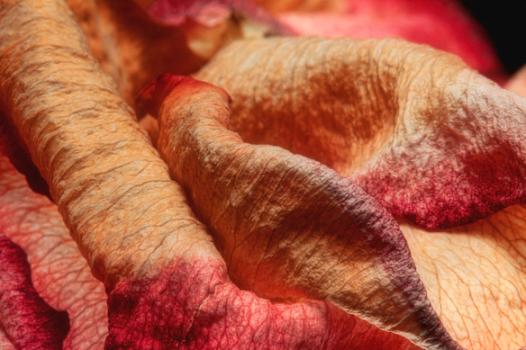
“Dried Rose Petals” by Tom Mc Nemar via Fineartamerica.
http://fineartamerica.com/featured/dried-rose-petals-ii-tom-mc-nemar.html
As time goes by, the rose potpourri takes over Cepes and Tuberose’s bouquet on my skin. The perfume smells increasingly like a very woody take on heavily spiced, cinnamon-dusted dried rose petals with an earthy humus note. Alas for me, the latter soon turns into hardcore porcini mushrooms, to a degree that Chypre Mousse never did. Actually, to be more precise, I smell like meaty, cooked portobellos dusted with cinnamon. The herbal green element has faded, though a certain pungency remains. The leathery note feels less musky, the raisins and brown sugar resin both weaken, and so does that subtle impression of pine. Their place is taken by a pinch of sweetened floral powder, presumably from the benzoin mingling with the roses.
I never once detected tuberose in its traditional, usual way. Instead, what slowly weaves its way through the notes is something that smells like a very browned gardenia. It strongly resembles the decayed gardenia in Serge Lutens‘ Un Voix Noire. As many of you know, gardenia is one of those flowers whose smell can’t really be captured from the petals, whose scent cannot be distilled, and whose aroma has to be recreated using other essential oils. (Fragrantica has a tiny bit on this issue if you’re interested.) Tuberose is one of the ways to recreate the smell of the gardenia, which may account for why the version in Cepes and Tuberose smells more like the latter than the former on my skin. Plus, gardenias naturally have a mushroomy scent when they are very ripe or close to the edge of decay.
On my skin, the browned “gardenia” is perhaps the most tertiary of notes, and everything is trumped by the cinnamon-infused dried roses. The cepes are like a Jack in the Box, popping up on occasion to say “Boo” before sinking back down. They feel less meaty at the end of the first hour, and are more dirt-covered with the lightest touch of a mossy undertone. None of it is easy for me, though I enjoy the new arrival on the scene: cocoa. The initial hint of something chocolate-like in the base has now risen to the surface, but it resembles semi-sweet, dry cocoa powder more than an actual block of heavy chocolate.
At the start of the second hour, Cepes and Tuberose is a bouquet of cinnamon-rose potpourri with coca-dusted dry woods on the surface, while a dark, decayed white floral and meaty portobello mushrooms lurk down below. It is simultaneously dry, dirty, dusty, sweet, sharp, spiced, pungent and soft — contradictory as some of those things may sound. It isn’t the easiest of scents for me, though I had a moment of hope about 1.75 hours into Cepes and Tuberose’s development. There, suddenly, there was an utterly lovely drydown of spiced warmth with cocoa powder, cinnamon benzoin, dried roses and a touch of sweet powder, all nestled in a dry-sweet embrace of cocoa-dusted woods. All the edges felt smoothed out, and the result was a delicious, quasi-gourmand that felt beautifully balanced. At times, there was even a subtle patchouli vibe (and you know how I love my patchouli).
Unfortunately, this stage was very brief on me, and I can only blame my skin. Something happened, and less than 30 minutes later, Cepes and Tuberose turned into the smell of dry dirt on me. Not sweet, loamy, wet soil, but very dry, old dirt, with touches of the other elements that I’ve described above. In its final moments, Cepes and Tuberose was nothing more than a blur of dryness that smelled vaguely like old dirt and potpourri. The whole thing lasted 4.75 hours with two small sprays, and 6.25 hours with a larger quantity. Generally, the sillage was very soft after an initially strong start, but Cepes and Tuberose was quite potent when smelled up close for a number of hours. In both my tests, it became a skin scent after 1.75 and 2.25 hours, depending on the quantity that I applied.
My struggles with Cepes and Tuberose really surprised me. Not only is tuberose my favorite flower in real life, but I love dark, woody, resinous or earthy scents. I certainly have no problems with humus or mushroom notes, as regular readers know from my ravings about Oriza’s Chypre Mousse. I can only chalk things up in this instance to skin chemistry and my personal tastes.
Others, however, have had much better luck with Cepes and Tuberose. Now Smell This has the perfume on its list of 100 things that every perfumista must try, calling it “dark, earthy and sexy.” Olfactoria of Olfactoria’s Travels who doesn’t like tuberose scents was actually driven to song, dance, and music, writing that the “deliciously intoxicating fumes” of the perfume brought out a part of her soul.
Meanwhile, Victoria of EauMG thought it was both sultry and akin to a chocolate-dipped pretzel, writing in part:
Cepes and Tuberose opens with sharp rosewood and hay. After this settles, it’s a big floral with blooming tuberose and dewy rose. It’s slightly sweet and lactonic but not too sweet or lactonic. It’s balanced by a savory saltiness. Think of it as the chocolate dipped pretzel of perfumes or even better yet, a peanut butter cup – a perfect balance of sweet and salty. The dry-down is an earthy yet sweet vanilla-benzoin. On my skin, the mushroom is rather faint. In fact, it is more like the animalic richness that is naturally present in “overripe” white florals. And because of this, Cepes and Tuberose is a rather sultry fragrance.
Perfume-Smellin’ Things found Cepes and Tuberose to be unique, and more akin to umami than to a tuberose scent. I think her umami comparison is extremely clever and astute:
Smelled on its own, tuberose absolute is as I know it, buttery, slightly mentholated and slightly rubbery. Smelled on its own, cepes absolute smells of soy sauce and red wine, a mouthwatering, “tongue-coating”, savory aroma. Smelled right after cepes, tuberose suddenly turns to me with a facet it hasn’t shown before … there is something in fact meaty there … meaty and dry and coated in earth…a certain piquant pungency that it took a mushroom to bring to light…or darkness, as it were.
The composition of Cepes & Tuberose is uncluttered. The two main ingredients are so rich, complex and charismatic, that any other notes have to be “quite simple. The cepes and the tuberose intertwined was all the star material that the perfume could aesthetically accommodate.” (M.Aftel) A little bit of citrus in the top notes brightens the fleshy dark brown of the blend; woods seem to both enhance the creaminess of tuberose and to add to the dry spiciness of porcini. This is undoubtedly one of the most unique tuberose perfumes – and much more than a tuberose perfume. It seems wrong to categorize it as a floral. But neither is it anything else really. It requires a new olfactory category of its own … Umami.
I think the review with which I agree the most is that of my friend, The Perfume Dandy, who accurately notes Ms. Aftel’s achievements in the vanguard of experimental, truly original, almost “avant garde” works in the olfactory plane. In terms of his actual experience with Cepes and Tuberose, he writes:
Cepes and Tuberose stands out for The Dandy as an idiosyncratic masterwork.
Meaty sweet mushrooms meet fleshy over ripe flowers in a carnal embrace that is splendidly earthy at the opening and morphs into an extraordinary splicing of library, forest and eccentric boudoir.
Truly original and quite remarkable.
This may not be a scent for everyone, but in a world of apparently endless choice (are there now more Angels in heaven or on the shelves of Thierry Mugler?) I, for one, am so glad that there are such creative options available.
I very much agree. Cepes and Tuberose isn’t the easiest of scents, and it isn’t for everyone. However, one must applaud Ms. Aftel for pushing the boundaries with something very unique. I have enormous respect for Ms. Aftel in general, but Cepes and Tuberose merely increases it, even if the scent did not work for me personally. To combine tuberose with fougère elements and to create an earthy tuberose with mushrooms… it is brilliantly original.


